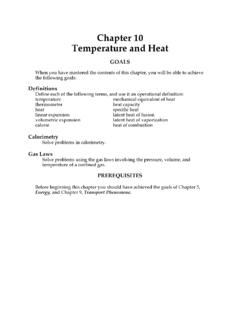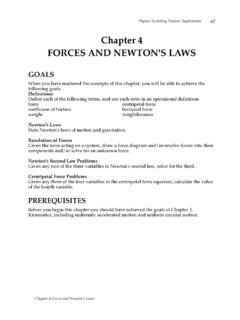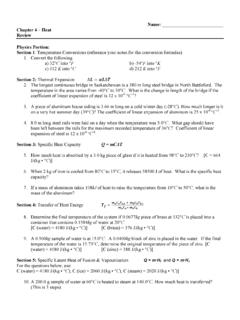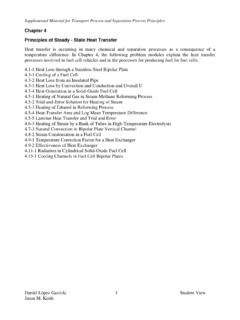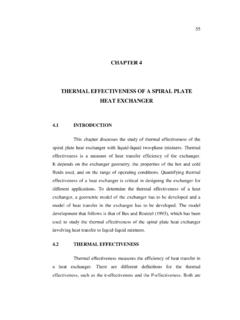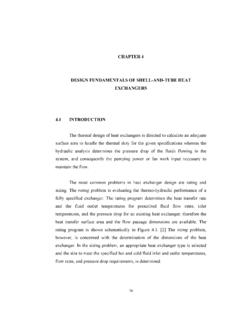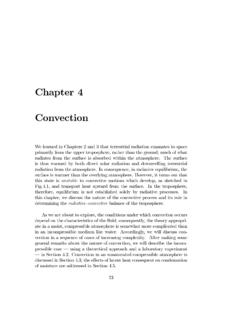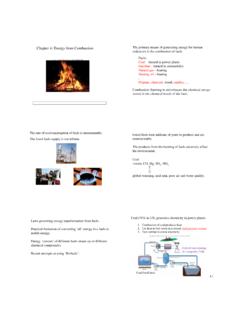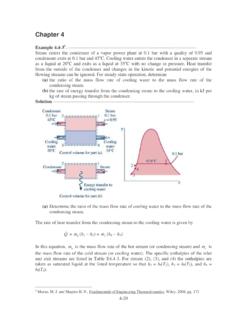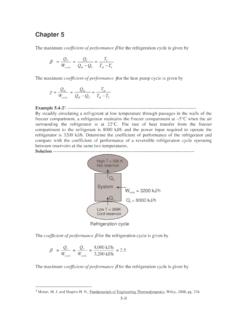Transcription of Chapter 10 Temperature And Heat - Doane College
1 Physics Including Human Applications 217 Chapter 10 Temperature And heat GOALS When you have mastered the contents of this Chapter , you will be able to achieve the following goals: Definitions Define each of the following terms, and use it in an operational definition: Temperature mechanical equivalent of heat thermometer heat capacity heat specific heat linear expansion latent heat of fusion volumetric expansion latent heat of vaporization calorie heat of combustion Calorimetry Solve problems in calorimetry.
2 Gas Laws Solve problems using the gas laws involving the pressure, volume, and Temperature of a confined gas. PREREQUISITES Before beginning this Chapter you should have achieved the goals of Chapter 5, Energy, and Chapter 9, Transport Phenomena. Physics Including Human Applications 218 Chapter 10 Temperature And heat Introduction Your interactions with your environment provide a variety of experiences that are related to the ideas of Temperature and heat . Some of your first autonomous decisions may have been your choices of clothing, choices at least partly influenced by the answer to the question, "What is the Temperature going to be today?
3 " You have had many opportunities to influence the Temperature of your food. Have you not burned your mouth on something too hot? What methods have you learned to use to cool your food down rapidly so that it is at the proper eating Temperature ? Your experiences may have included a number of injunctions that contradict one another. For example, you may think that all water boils at the same Temperature , and that water never gets hotter than its boiling Temperature , yet the cookbook says to cook the rice in water that is at a "rolling boil.
4 " Why? In addition to contradictions, our cultural lore is full of interesting, and perhaps false, statements about Temperature and heat : "Hot water placed outside on a very cold winter day will freeze faster than cold water." "A steam burn is worse than a hot water burn." "White clothes are cooler than dark clothes." Furthermore, your first-hand experiences with heat and Temperature are not without puzzles. On a hot summer day why would a piece of metal lying on the sidewalk seem hotter to your bare feet than the concrete?
5 Such puzzles helped lead to the present quantitative ideas about Temperature and heat . Count Rumford, one of the forefathers of our modern concepts of heat , noted in his personal diary that each time he saw a person burn his mouth on hot apple pie, he wondered what it was about apples that made them seem to retain their heat much longer than other foods. The point of these observations is that you already have had many encounters with the concepts of Temperature and heat . The purpose of this Chapter is to discuss these concepts in a way that will give you some quantitative understanding of them and will correct any misunderstandings that you have.
6 Temperature One of the first discriminations you learned was the relative hotness or coldness of an object using the heat sensing organs of your body. However, you also learned that this discrimination was not very reliable. Bath water that feels only slightly warm to your hand may feel rather hot when you sit down in it. The cookbook says, "Bake in a hot oven for two hours." The novice cook is puzzled by the term "hot" oven, just what is a hot oven anyway? How hot does an oven have to be to be a hot oven? To answer this question we need to define some common measures of hotness that can be used by different people.
7 We use the term Temperature to speak about the relative hotness or coldness of an object. We then set out to develop some Temperature scales that can have universal use. The human heat sensors are transducers that change the heat energy input into electrical signals that are sent to the brain (see Chapter 1). But we know how unreliable those transducers are for use in defining any universal temperatures . Therefore, we must find some other kinds of transducers that Physics Including Human Applications 219 have reproducible, quantitative responses to changes in Temperature .
8 Such transducers are called thermometers. In this context Temperature can be operationally defined as the property of a system measured with a thermometer. A system that has a reproducible linear relationship between Temperature and a change in a physical property of the system seems to be a logical choice for a thermometer. A list of some of the kinds of thermometers that are presently in use is given in Table None of these transducers is completely satisfactory for all uses and for all ranges of Temperature .
9 The best thermometer for a particular use must be selected by taking into account such factors as cost, accuracy, Temperature range, and durability. Once you have selected a transducer system to use for your thermometer, you must establish some way of calibrating it. That is, you need to determine a numbering system that you can use to measure various temperatures . If you wish other people to be able to use your Temperature system, you will need to find some events in nature that always occur at the same Temperature .
10 You can use these events to serve as reference, or fixed, points on your thermometer. Based on these ideas, the first accurate thermometer was made in 1641 using alcohol in glass. Then in 1714 the German physicist G. D. Fahrenheit built a mercury-in-glass type thermometer and used three fixed points to calibrate it: the freezing Temperature of a mixture of water, ice, and salt which he labeled 0 , the freezing point of pure water labeled 32 , and the Temperature of the human body labeled 96 . Please note that this Temperature does not agree with current normal body Temperature .
